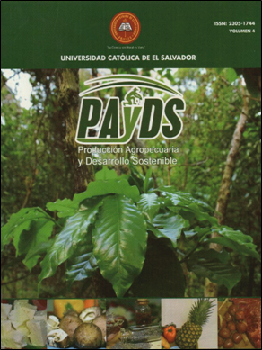Efecto antihelmíntico in vitro de extractos vegetales en nematodos gastrointestinales de ovinos de pelo
DOI:
https://doi.org/10.5377/payds.v4i0.3961Palabras clave:
Nematodos, resistencia antihelmíntica, metabolitos secundario, extractos, PROBITResumen
Debido al incremento de resistencia de los nematodos gastrointestinales (NGI) a los antihelmínticos, se propuso como objetivo evaluar in vitro la eficacia de extractos de diferentes plantas. Se formularon extractos hidroalcohólicos que se aplicaron sobre huevos y larvas infectantes (L3) de NGI. En el caso de las larvas se realizaron dos pruebas: en la primera se usó extracto de guaje (L. diversifolia), conacaste negro (E. cyclocarpum) y pega-pega (D. tortuosum); y para el segundo bioensayo se utilizó el extracto de guaje (L. leucocephala), mangle (R. mangle) y neem (A. indica). En la prueba de inhibición de la eclosión de huevos (IEH) se usaron hojas de neem (A. indica), de hierba santa (P. auritum) y de hierba del zorrillo (P. alliacea).
Los huevos y larvas se obtuvieron de ovinos infectados de manera natural en pastoreo. Las larvas infectantes se desenvainaron con hipoclorito de sodio (0.187%), después se agregaron 100 larvas por pozo en agua destilada y se desafiaron con los extractos a través de una prueba in vitro de motilidad larval con observación directa. Los resultados mostraron que los extractos de L. leucocephala y A. indica presentaron un grado de acción larvicida en NGI similar a levamisol. Con el extracto de L. leucocephala se obtuvo la menor dosis letal (DL50=0.045mg/ml-1) contra L3. En la eclosión de huevos, los mejores resultados se obtuvieron con el extracto de P. alliacea y P. auritum
Producción Agropecuaria y Desarrollo Sostenible, Vol. 4, 2015: 11-25
Descargas
1333
Descargas
Publicado
Cómo citar
Número
Sección
Licencia
© Producción Agropecuaria y Desarrollo Sostenible
El copyright de los artículos se transfiere a la revista Producción Agropecuaria y Desarrollo Sostenible.
Como usuario de esta revista, usted posee:
● Acceso abierto para consultar la información contenida en este número
● Permiso para copiar, distribuir, mostrar, realizar o combinar las prácticas anteriores, en cuanto al uso de la información, siempre y cuando esta sea estrictamente sin fines de lucro.
Este revista utiliza una licencia CC BY-NC

Este obra está bajo una licencia de Creative Commons Reconocimiento-NoComercial 4.0 Internacional




